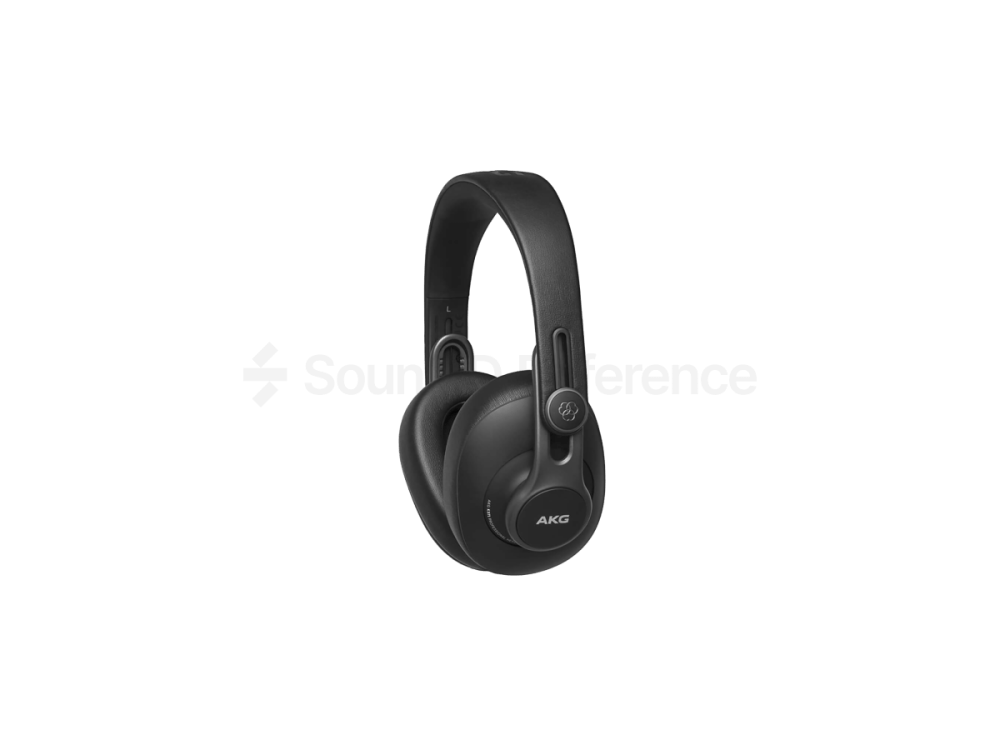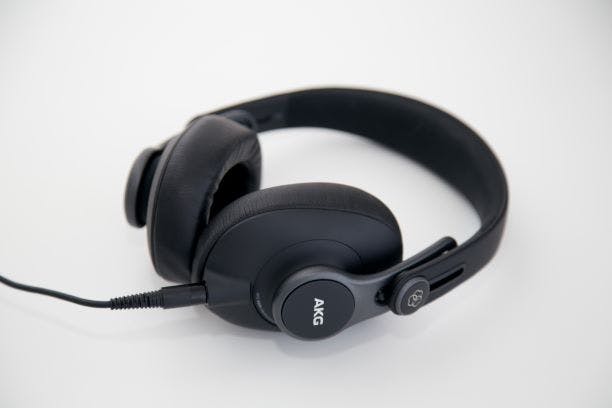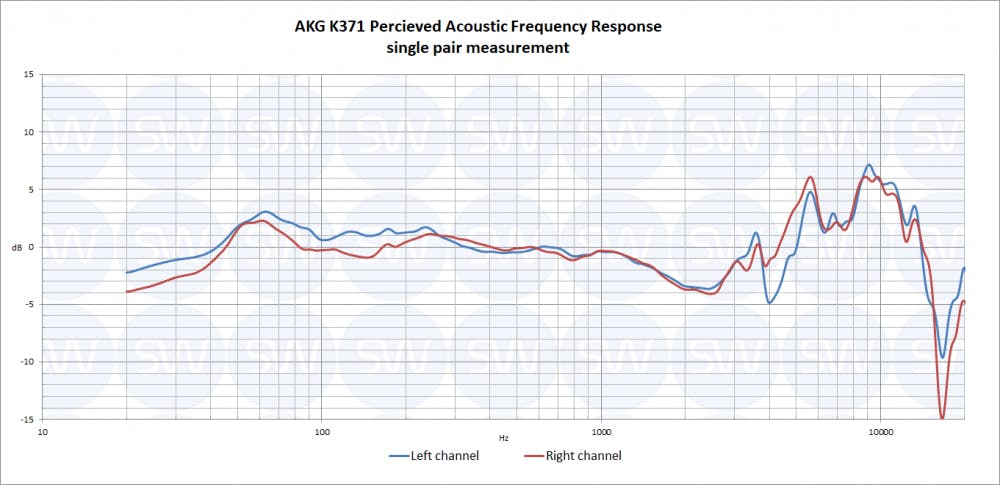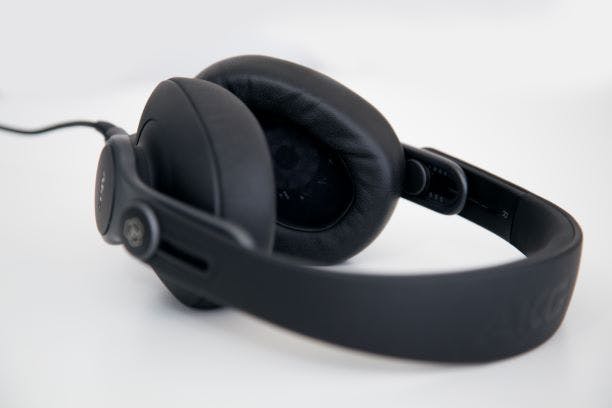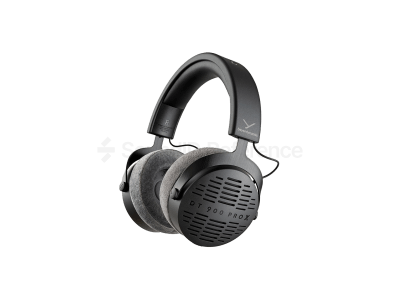Fairly recently AKG released a number of new closed-back studio headphone models. Let’s take a look at the one with the highest number of the bunch, the K371. “Luxury feel and AKG Performance” states the K371 website. Let’s see how they deliver!
- Class leading comfort
- Good build quality
Pros list with SoundID Reference calibration
- Neutral sounding high frequencies
- Extended sub bass response
- Worse adaptiveness than some of its rivals
While there are a few metal parts, most of the build is plastic, but solid, reassuring plastic. The materials used in most recent over and on-ear studio headphones, including K371, are way nicer to touch and more premium-feeling than say Audio-Technica ATH-M50x or Beyerdynamic DT 770 Pro, which seem to be more concerned by function alone. The padding-less silicone headband cushion is another trend that’s on the rise with newer models. The outside of the headband is wrapped in really nice faux leather. That paired with the gentle and soft ear pads gives some weight to the “Luxurious feel and AKG performance” slogan. For this price segment, they do feel luxurious.
With the cable detached, K371 can be neatly folded to save some space in your backpack. A waterproof carrying pouch is also included. They’re very portable for their size.
A short segment of the wire that connects both ear cups is exposed which is not ideal as it makes it vulnerable, however, of all the headphone designs that opt for the external wire routing, K371 provides perhaps the most protection for the wire by routing it in between the metal ear cup holders.
K371 manages to keep the mid-range neutral in vast bandwidth of about 100 Hz up to about 1 kHz beating even the Shure SRH1540 in this regard. However, the higher frequencies get a boost, not to a point that makes cymbals and high hats ear-piercing but definitely makes the sound bright. For recreational listening many will find this coloration pleasant, but this is something to keep in mind while working on audio. The bass response is elevated for most of the measured pairs, somewhat like this particular one shown on the graph, but most pairs are lacking sub bass extension. Either way, even for the pairs with increased bass, the boost is conservative and is not overbearing.
Sadly, channel balance isn’t great. On two of the four pairs measured, there were either left to right deviations of about +/- 4 dB throughout the spectrum, or about 3 dB bass response disbalance. It’s not that this issue will destroy the stereo perception for the listener, but if you’re unlucky and get one of the worse pairs, dialing in the stereo field might get confusing, especially if you’re cross-referencing against speakers. The remaining two pairs were with more minor issues in this regard. Of course, we’ll never be able to measure all of the headphones out there and with the limited sample pool it’s impossible to tell how common this disbalance is, but if you’re working with K371 and struggle with your stereo decisions translating well to other systems, it’s possible your headphones are misleading you.
Comfort is K371 forte. The silicone headband is great at balancing out the pressure and ear pads are nice and soft. The closed-back design paired with the pleather-wrapped ear pads inevitably lead to heat build-up inside which after some time wearing them most probably will lead to sweaty ears, but other than that, no issues came up among our testers. Overall, these are some of the most comfortable options on the market today, in their respective price bracket.
AKG manages to pack in considerable value for a relatively affordable price with the K371. They’re well put together, can be worn for an extended period of time and feel nice in your hands. And you get 3 different cables! Other than Beyerdynamic DT 770 Pro’s or Beyerdynamic Custom series, there aren’t really other closed-back headphones in this price category that can challenge K371 comfort.
K371 performance in terms of low THD is very good. As long as you’re listening at sensible levels, there will be no perceivable harmonic distortion to worry about. Only when you’re really cranking it up to borderline painful sound pressure levels the sub bass clarity begins to suffer, and only marginally.
How accurate and consistent is the correction effect among different listeners?As with most AKG models, adaptiveness is worse than some of its rivals. This leads to different listeners perceiving a bit different frequency response. A big factor that contributes to that is that the perceived frequency response changes noticeably depending on the position on the listener’s head. This is the downside of the comfortable ear pads that allow you to wear headphones in a relatively wide range of positions without losing comfort. Unfortunately, calibration accuracy suffers.
How much do they differ pair to pair in terms of frequency response?There’s about +/- 3 dB spread in bass response among the measured pairs. The rest of the spectrum has some narrow bandwidth differences but nothing severe. Manufacturing consistency is not the best we’ve seen in this price segment, but it’s not the worst either.
Rating
Conclusion
Few headphones can compete with the frequency response of K371 and the build quality is great, but perhaps where these headphones excel the most is comfort. However, all the good traits of this model are undermined by poor adaptiveness which hurts the accuracy of the perceived frequency response. The result of that is that you won’t be able to entirely trust that what you’re hearing will translate well to other playback systems and you can’t even be sure that other people wearing the same headphones will hear the same that you’re hearing. Sadly, this makes it hard to recommend these otherwise great headphones as a professional monitoring tool for mixing and mastering. But for applications where comfort is more important than accuracy, K371 is worth consideration.
You can order individual calibration for your AKG K371 headphones from our store here.
For more information about AKG headphones, please read our other reviews – AKG K612, AKG K712 Pro, and AKG K240.
Continue to discover our top recommended PRO studio headphones in our Top 24 list.
Final Rating
Calibration Enabled
Calibration
